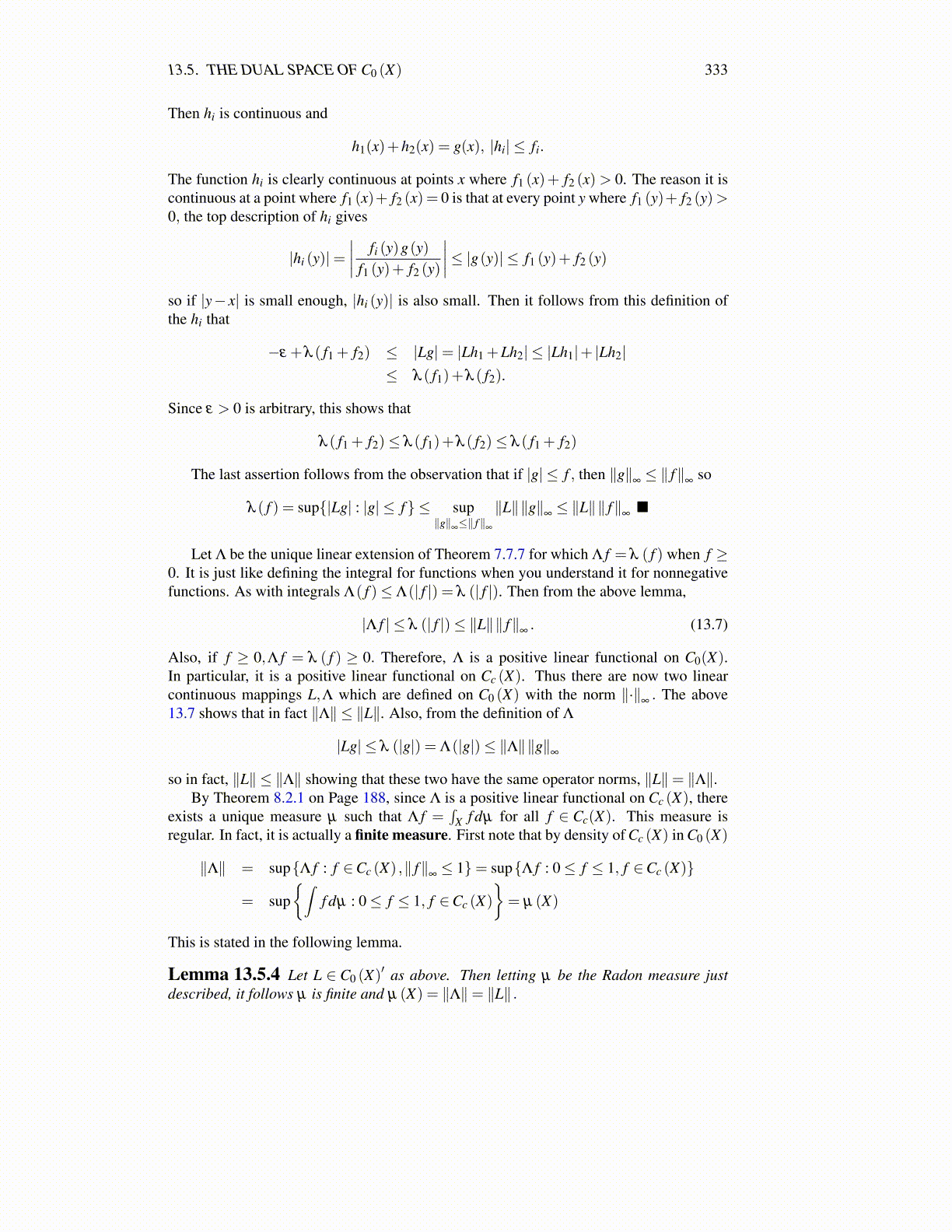
13.5. THE DUAL SPACE OF C0 (X) 333
Then hi is continuous and
h1(x)+h2(x) = g(x), |hi| ≤ fi.
The function hi is clearly continuous at points x where f1 (x)+ f2 (x)> 0. The reason it iscontinuous at a point where f1 (x)+ f2 (x) = 0 is that at every point y where f1 (y)+ f2 (y)>0, the top description of hi gives
|hi (y)|=∣∣∣∣ fi (y)g(y)
f1 (y)+ f2 (y)
∣∣∣∣≤ |g(y)| ≤ f1 (y)+ f2 (y)
so if |y− x| is small enough, |hi (y)| is also small. Then it follows from this definition ofthe hi that
−ε +λ ( f1 + f2) ≤ |Lg|= |Lh1 +Lh2| ≤ |Lh1|+ |Lh2|≤ λ ( f1)+λ ( f2).
Since ε > 0 is arbitrary, this shows that
λ ( f1 + f2)≤ λ ( f1)+λ ( f2)≤ λ ( f1 + f2)
The last assertion follows from the observation that if |g| ≤ f , then ∥g∥∞≤ ∥ f∥
∞so
λ ( f ) = sup{|Lg| : |g| ≤ f} ≤ sup∥g∥∞≤∥ f∥∞
∥L∥∥g∥∞≤ ∥L∥∥ f∥
∞■
Let Λ be the unique linear extension of Theorem 7.7.7 for which Λ f = λ ( f ) when f ≥0. It is just like defining the integral for functions when you understand it for nonnegativefunctions. As with integrals Λ( f )≤ Λ(| f |) = λ (| f |). Then from the above lemma,
|Λ f | ≤ λ (| f |)≤ ∥L∥∥ f∥∞
. (13.7)
Also, if f ≥ 0,Λ f = λ ( f ) ≥ 0. Therefore, Λ is a positive linear functional on C0(X).In particular, it is a positive linear functional on Cc (X). Thus there are now two linearcontinuous mappings L,Λ which are defined on C0 (X) with the norm ∥·∥
∞. The above
13.7 shows that in fact ∥Λ∥ ≤ ∥L∥. Also, from the definition of Λ
|Lg| ≤ λ (|g|) = Λ(|g|)≤ ∥Λ∥∥g∥∞
so in fact, ∥L∥ ≤ ∥Λ∥ showing that these two have the same operator norms, ∥L∥= ∥Λ∥.By Theorem 8.2.1 on Page 188, since Λ is a positive linear functional on Cc (X), there
exists a unique measure µ such that Λ f =∫
X f dµ for all f ∈ Cc(X). This measure isregular. In fact, it is actually a finite measure. First note that by density of Cc (X) in C0 (X)
∥Λ∥ = sup{Λ f : f ∈Cc (X) ,∥ f∥∞≤ 1}= sup{Λ f : 0≤ f ≤ 1, f ∈Cc (X)}
= sup{∫
f dµ : 0≤ f ≤ 1, f ∈Cc (X)
}= µ (X)
This is stated in the following lemma.
Lemma 13.5.4 Let L ∈ C0 (X)′ as above. Then letting µ be the Radon measure justdescribed, it follows µ is finite and µ (X) = ∥Λ∥= ∥L∥ .